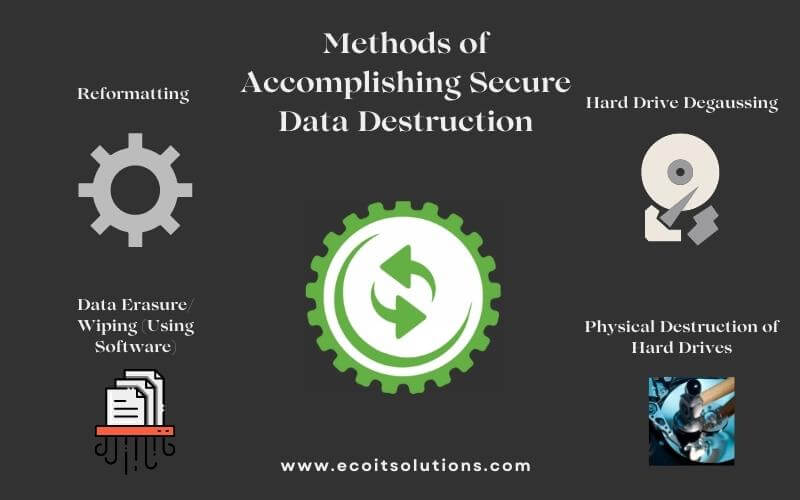Enhancing Cyber Security through Advanced Data Destruction Techniques
Enhancing Cyber Security through Advanced Data Destruction Techniques
Blog Article
Exploring the Relevance of Data Damage in the Context of Computer Security Solutions and Protecting Confidential Data
In an era where data violations are significantly usual, the significance of effective information destruction can not be overemphasized. When no longer necessary, Organizations has to embrace rigorous measures to make sure that sensitive info is not just secured throughout its lifecycle yet additionally decisively eliminated. The methods employed for information obliteration, paired with conformity to legal standards, play a crucial function in maintaining confidentiality and trust. Nonetheless, the ramifications of these practices expand beyond plain compliance, affecting a business's reputation and functional integrity in the electronic industry. What methods can organizations implement to boost their data damage procedures?
Recognizing Information Damage
Data devastation is an important element of computer system security that includes the irreversible removal of data from storage gadgets to protect against unauthorized access and prospective information violations. In an increasingly digital landscape, organizations deal with enhanced threats related to sensitive info being incorrectly accessed or manipulated. Reliable information destruction safeguards against these risks, guaranteeing that confidential dataâEUR" such as client details, intellectual home, and monetary recordsâEUR" can not be recouped after disposal.
Understanding the value of data damage expands past plain conformity with lawful and regulative frameworks; it is important for preserving business integrity and count on. When information is poorly handled or inadequately damaged, the consequences can be serious, including monetary loss, reputational damage, and lawful obligations.

Techniques of Information Removal

One widespread technique is information cleaning, which entails overwriting existing data with arbitrary patterns numerous times. This method provides the initial data irretrievable, making it a prominent option for companies seeking to secure private details.
One more method is degaussing, which uses an effective electromagnetic field to disrupt the magnetic domain names on storage space tools, effectively getting rid of the information. This strategy is specifically reliable for magnetic media yet is not relevant to solid-state drives.
Physical devastation is one more robust method, involving the shredding or crushing of storage space gadgets. This method guarantees that information recuperation is essentially impossible, making it optimal for highly sensitive details.
Finally, file encryption can serve as a corresponding strategy to data removal. By securing information prior to removal, companies can add an added layer of protection, making sure that even if residues are recuperated, they remain inaccessible without the decryption trick. Each technique should be picked based upon the level of information sensitivity and the specific protection demands of the organization.
Legal Conformity and Data Protection
Organizations need to navigate an intricate landscape of legal needs associated to data safety, especially after applying techniques of information elimination. Various guidelines, such as the General Data Security Law (GDPR) and the Medical Insurance Transportability and Responsibility Act (HIPAA), impose strict standards on just how companies have to dispose and handle of delicate data. Failing to abide by these guidelines can lead to significant lawful consequences, including considerable fines and reputational damage.
Data destruction procedures should be meticulously recorded to demonstrate compliance with applicable regulations and standards. This documents not just acts as evidence of adherence to lawful responsibilities however likewise highlights a commitment to securing delicate details. Organizations needs to also establish clear policies relating to information retention and devastation timelines, making certain that information is not held longer than necessary.

Moreover, regular audits and assessments of data damage practices are important to maintain compliance and adjust to advancing lawful frameworks (data destruction). By proactively addressing lawful needs, companies can reduce risks connected with information violations and demonstrate their dedication to information safety and security. Ultimately, focusing on lawful compliance in information damage processes is not simply a regulative responsibility, but a basic element of a robust information security strategy
Influence On Service Track Record
The credibility of a business can be dramatically affected by its approach to information destruction and monitoring. In today's digital landscape, where information breaches can take place at any type of minute, the failure to effectively throw away sensitive details can result in extreme repercussions. Organizations that improperly manage information destruction danger revealing private consumer information, which not just violates privacy regulations but likewise deteriorates count on amongst stakeholders and clients.
A ruined reputation can lead to lowered customer commitment, as customers come to be hesitant to engage with an organization that has demonstrated oversight in protecting their data. Negative promotion surrounding an information violation can have a long-term effect, as potential clients may be hindered by the regarded absence of security. This can result in a direct decline in profits and market share.
Additionally, organizations that focus on information devastation as component of their protection strategy can enhance their reputation by showcasing their commitment to safeguarding sensitive information. By embracing rigid information monitoring practices, organizations can not only reduce dangers however likewise position themselves as credible entities in their particular markets, therefore strengthening their overall brand picture.

Finest Practices for Secure Disposal
Executing finest techniques for safe and secure disposal of information is vital for alleviating dangers connected with information violations and making sure compliance with privacy regulations. Organizations needs to embrace an extensive information disposal policy that outlines treatments for both electronic and physical data additional info devastation.
For physical data storage space devices, such as hard disk drives, shredding or degaussing is suggested to stop information recuperation. Furthermore, organizations need to preserve a chain of protection documentation throughout the disposal process, making sure responsibility and traceability of disposed things.
For digital information, using software program that complies with sector standards for information wiping is critical. This software program should overwrite existing information multiple times, making healing virtually impossible. It is additionally important to confirm the efficiency of the information destruction process with audits or third-party analyses.
Training workers on safe and secure disposal practices adds one more layer of safety, as human mistake can frequently cause information exposure. Frequently updating and assessing disposal policies guarantees positioning with advancing regulations and technological improvements. By applying these ideal techniques, organizations can considerably decrease the danger of unapproved information gain access to and improve Full Report their total information defense strategy.
Conclusion
To conclude, data destruction is a fundamental aspect of computer system security services that makes certain the defense of secret information from unapproved accessibility. Carrying out reliable approaches of information elimination, adhering to legal conformity, and identifying the influence on company credibility are vital components of a comprehensive information protection method. By embracing best techniques for safe disposal, organizations can foster trust fund with Continued customers and protect delicate information, ultimately adding to an extra protected digital landscape.
In a period where data breaches are significantly common, the importance of efficient data devastation can not be overstated.Data devastation is an essential element of computer safety that involves the irreversible elimination of information from storage tools to avoid unapproved access and possible data violations. Organizations ought to additionally establish clear plans regarding data retention and devastation timelines, guaranteeing that information is not held longer than required.
By proactively resolving legal demands, organizations can alleviate threats associated with information violations and demonstrate their commitment to data protection (data destruction). Ultimately, focusing on lawful compliance in data devastation procedures is not just a regulative commitment, but an essential element of a durable information safety and security approach
Report this page